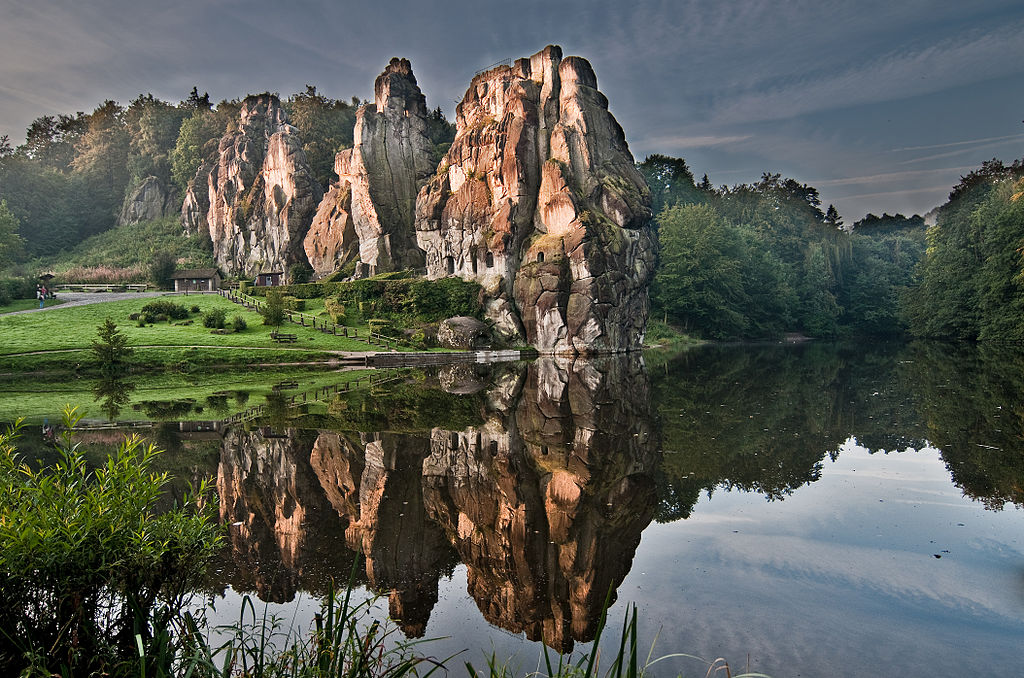It was as if the gods of dim antiquity stood before us, brooding amidst the slowly dissipating mist of early morning.
High above ravens rasped a rough-throated song that was caught by the wind and tossed toward the rising summer sun.
We had finally arrived after a two-hour hike in the Teutoburger Forest. Before us stood in silence the Externsteine, Germany’s Stonehenge, a looming outcrop of five enormous, weathered, limestone pillars, rising nearly 30 meters above the forest.
They were formed during the Cretaceous period, 70 million years ago, almost before time itself. When I saw these rocks, like Frost-giants of myth, my mind began to wander.
his was once a holy site for the ancient Germanic people, the place where their sacred oak tree of life, Irminsul, grew as a living shrine to the old religion. But the old ways yielded to the new, and in 772 AD,
Charlemagne outlawed all pagan forms of worship, and cut down the ancient oak tree, thus forever severing the people from their pagan past. As if lost in a mist of dreams, my friends and I wandered about peering into man-made caves and clefts carved by hands now forgotten.
I found myself walking up steps that led nowhere, or suddenly coming upon a row of neatly drilled holes that now defied explanation. In the widest pillar stands a chamber of irregular shape, accessed by two entrances; the two windows that face me frame the midsummer sunrise.
The highest rock is accessed by carved steps and a dubious foot-bridge. It houses a roofless chamber, called the Chapel, where we find a round niche with a pillar altar, above which stands a perfectly circular window, some 35cm in diameter.
Much scholarly ink has been spilt on the various possible uses for this Chapel; but only one fact is certain: It is constructed according to astronomical orientations. The round window frames the moon at its most northerly rising, and during summer solstice, it catches the light of the sun.
When Charlemagne destroyed the Irminsul tree, he allowed monks to take over the sight so it could be put to Christian use. Their marks are everywhere. Chief among these is a carving from about 1120. It is a playful mixture of Christian and pagan beliefs – a mentality that is so hard to recuperate now.
The carving shows the Irminsul, the prime symbol of the old religion, bent to form a chair, upon which Nicodemus stands to lower the body of Christ from the cross. This is to show the subjection of the old religion to the new. But curiously the legs and feet of Nicodemus are missing.
Below the Irminsul is the World Serpent from Germanic myth who supports the earth. Here we have a snapshot of some ancient mind that we cannot know, other than what we assume. Geography and cosmology here is rooted in Christianity, even if it is supposedly pagan by the more romantic.
My friends and I spend several hours among the silence of the rocks — until the crowds begin to arrive — like all popular places it is difficult to be always alone with antiquity.
It is time for breakfast anyway, and we leave the creased faces of these hallowed rocks to the next batch of inquisitive visitors. In a clearing, we open our rucksacks and dig into our breakfast.
A delicious way to awaken from a dream. As I bite into my bread, I hear a flap of wings, and looking to my right, beneath a young oak tree, two ravens sit silently, watching me eat. Perhaps it was these ravens that I heard as we first came upon the Externsteine. They don’t seem frightened and are hardly shy.
Silently, quietly they sit, watching. In acquiescence to their presence, I break off two pieces of my bread and throw it to them. They eat in a very dignified manner, without rushing, without greed.
It is then I recall that in Germanic myth two ravens ever attended the god Odin. Perhaps the old gods are not dead; perhaps they come alive if we remember. I break off more bread and place it before the ravens, this time as offering.
